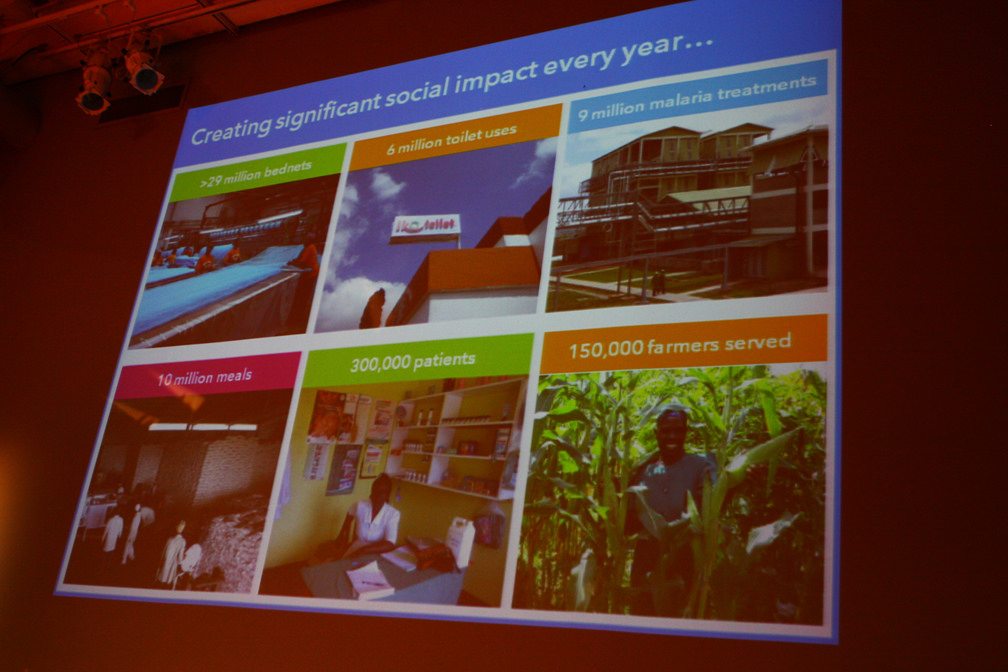Fund Your Idea
How to take your social venture pitch to the next level
Use these ideas to craft a compelling pitch to boost awareness and secure funding for a social venture.
July 31, 2018
When it comes to pitching, first impressions count.
Trying to distill the essential details of your social startup into a three to five minute presentation is no easy feat. You’ll need to communicate how your offering stands out and the real impact it can generate in both a succinct and memorable way.
Luckily, there are some key best practices that can increase your chances of crafting a pitch that resonates. It is impossible to share everything about your social startup in a few minutes, so the goal of a pitch is to activate the listener’s interest and get them knocking on your door to continue the conversation.
Pitch Tip 1: Know your 'investment story'

Every pitch needs to have an ‘investment story’. Cathy Clark of the Case Center for the Advancement of Social Entrepreneurship at Duke University’s Fuqua School of Business recommends having a consistent and compelling ‘investment story’ that will resonate with investors. Knowing your investment story “gives investors a frame to understand your strategic pathway for growth and impact - so they can see how to aid you on that pathway.”
You’ll be able to tell one of four types of investment stories depending on the type of solution you have, the stage of your company, and the type of investors you want to target.
Some types of investment stories will influence social impact more than profitability, while others will emphasize the potential rate of return over the social value proposition. Knowing the priorities of the audience will help determine the frame within which you tell your investment story.
In this webinar that Global Innovation Exchange ran in partnership with CASE Smart Impact Capital, they outline four primary investment stories which can be summarized:
- High Growth Opportunity - exploiting an impact opportunity that will deliver market rate returns.
- Innovation Play - using a novel approach that could disrupt an industry, including better impact.
- Impact Delivery - delivering real impact through a scalable model.
- Addressing Underserved Need - sustaining a business that solves an important problem for an underserved population.
Pitch Tip 2: Know your audience

Different types of stories will resonate with different types of investors, so knowing your audience is key to crafting a pitch presentation that connects.
As Phin Barnes of First Round Capital shared, “the whole goal as a founder is to move investors from a fear of failure to a fear of missing out.” However, to make that happen, you need to understand what motivates them.
The pitch for a large competition will be quite different than a closed investment meeting because the audience’s perspective is quite different.
You don’t want to alter your core message too drastically as you speak to different audiences but you may need to tailor your presentation so that you can address their specific questions. If you find yourself needing to drastically change your core story in order to please an audience, chances are you aren’t presenting to a group that is aligned with your needs.
Pitch Tip 3: Balance vision and details
Leading a social venture requires believing that the status quo can be improved; it's not an easy or simple path. This work requires communicating an audacious vision that will compel people, and a pitch needs to channel this same energy.
A moving pitch also backs up bold vision with a sound plan to demonstrate that you have thoughtfully considered the operational steps needed to execute.
Pitch Tip 4: Balance stories and figures

Photo: Jessica Lehrman
Humans are hardwired for stories, but many are also left-brained and analytical. Especially if you are seeking funding, sharing key financial figures is essential to show that you have a handle on your numbers and the unit economics. Demonstrate that you have a good understanding of how to scale your solution in a repeatable and sustainable way.
Similarly, figures can be moving when used to frame the problem or back up your assertions with statistics. For example, sharing that only 17% of recent grads say that career centers are ‘very helpful’ validates a much larger issue compared to having a quote from one student saying that he didn’t have access to resources.
Your pitch will leave an impression when stories are backed up by statistics.
Pitch Tip 5: Clearly show how you create value

Photo: Ryan Lash / TED
At the heart of your pitch needs to be an explanation of how you will create value. This includes a description of who you serve, what you offer them, and why it will be meaningful to them. You want the listener to be able to clearly picture what the product or service is and how it stands apart from alternatives in the marketplace.
If your solution is highly technical, make sure you describe it at a level that is easy for the average person to understand. You can use a ‘neighbor test’ to run your idea past a friend who’s unfamiliar with the space to see how well the message is received.
The best way to demonstrate that your customers care about the solution you offer is to demonstrate an unbiased track record of past results and impact. This can be a blend of individual success stories or testimonials, historical financial growth, or endorsements from leaders in the space. Play to your strengths and showcase the best proof you have that your business is gaining real traction.
Pitch Tip 6: Highlight team experience + credibility
The execution of your idea will come down to the strength of your team. Your pitch should highlight their background, expertise and credentials relevant to the venture. Showing that you have a strong and well-rounded team who has prior experience reduces some of the operational risk that investors will be looking to minimize.
The audience will also be listening for a demonstration of the core team’s level commitment to and passion for the cause. Don’t be afraid to let your enthusiasm shine through.
It’s also helpful to include any mentors or programs affiliated with your company in the team portion of the pitch.
Pitch Tip 7: Stand out

Photo: Jessica Lehrman
Think back to the pitches you’ve seen in the past; which ones stand out the most in your memory? Chances are you remember a dynamic presenter just as much as the corresponding idea itself.
If you let your personality shine through, the audience is more likely to connect with you as a person. They will listen more attentively during the presentation and better remember it in the future. Be prepared and polished, but don’t be afraid to be yourself. Integrate some humor or share related personal anecdotes if they fit naturally with your presentation and personal style
Another way to stand out is to integrate something tangible. If you sell food, bring samples for the investors or competition judges. If you have a product, show a prototype or quick and simple demo. For any offering you can prepare a one-pager that they audience can review after the pitch.
Finally, give extra thought to the opening and closing lines of your presentation and consider how you can make those key moments stand out in your own way.
Pitch Tip 8: Use visuals to support your message

Photo: Jessica Lehrman
The design of your slide deck can also meaningfully influence your audience. Take the time to invest (time or money) in a professional looking design that will support your overall message.
Remember that the words on the slides should reinforce key messages, not distract from them. You want to avoid the mistake of including too much text on your slides, which causes the audience to stop listening and start reading. (The caveat to this tip is if you are preparing a slide deck that will be sent to investors by email. In this case you can add more text to outline the full presentation.)
Use images, charts and graphs to creatively display information and keep the audience engaged. When describing numbers or abstract concepts, ask yourself how you can make the information more concrete by using clever visuals or analogies.
Pitch Tip 9: Be clear and concise

One of the most challenging elements of pitching is getting your message across in a short amount of time. In a three to five minute presentation there will be information that you don’t have time to explain in detail.
Run your pitch by several people who are not familiar with your work to see what questions they ask afterwards. If there are parts that are confusing, keep re-working them until you can share the idea in a clear and streamlined manner.
You can use analogies to get complex concepts across in less time or include testimonials and stories to convey qualitative impact and quickly demonstrate social proof to validate your progress.
Remember, the goal of a pitch is not to overwhelm the listener with information. Instead, it should provide enough context to provoke interest in continuing the conversation.
Pro tip: There will be some ideas that are non-essential but still feel important to share. One option is to strategically leave this information for the question and answer period; touch on the idea briefly in the main presentation and let the investors or judges you are presenting to follow up and ask you more about it.
Pitch Tip 10: Don't shy away from financials
Sharing financial information is key! In addition to your historical financial results, you need to demonstrate projected financials as well.
If you are asking for funding, be sure to include how the requested funds will be used and how those investments will serve to grow the revenue and impact of your company, and in what time frame.
Be ambitious with your projections, but make the connection back to current results in a logical and reasonable way. Investors know better than anyone that projections are not set in stone, but they certainly want to understand how you are thinking about the future in terms of assumptions and expectations.
Pitch Tip 11: End with a clear ask

Photo: Stacie McChesney / TED
There is one main element that distinguishes a pitch from any other type of presentation, and that is ending with a clear call to action.
The goal of a pitch is to enrol the audience or listener in supporting your cause. With a typical fundraising pitch, the call to action is a request for funding, but there are other potential asks.
You could ask your audience for introductions or to help spread news of your product or service within their network, or for certain expertise that could move the business forward.
A smooth way to transition into your ask is to frame it around next steps. Explain how the listener can be part of spreading your solution to those who need it and help achieve your vision for change.
When Acumen spoke with Morgan Simon, she pointed out that, “Investors want to be helpful,” but “make sure you have tangible asks about what you need. If you give them concrete bullet lists, people usually respond.” Phin Barnes, a partner at First Round Capital similarly shared a story of an entrepreneur who asked for an introduction to another founder. It was a clear ask that the investor delivered on.
Having a very specific ask not only makes your pitch more memorable but it’s also much easier for your listeners to follow through on a concrete request.
Pitch Tip 12: Practice, practice, practice

Standing up and pitching can be nerve-wracking, whether you’re standing in front of an auditorium of hundreds of people or a small group in a boardroom.
The good news is that the more you pitch, the easier it gets to do, and the pitch itself becomes smoother.
When you first practice, it’s often helpful to write out a script for your pitch. This doesn’t mean you will deliver it from rote memorization, but drafting your presentation will help you consider multiple ways to explain each concept and pick the language that is most effective and concise to get your message across.
Once you have your slide deck and key talking points mapped out, a polished pitch simply takes practice, practice, practice. Read through your notes out loud several times. Record yourself speaking and listen back to it.
After you have prepared the script and practiced on your own, gather friends or family to run through several ‘mock’ pitches. This gives you the opportunity to work through any sticking points that may need to be revised before the official presentation.
Pitch Tip 13: Follow up
Finally, don’t let the excitement generated during your pitch go to waste afterwards. Make a plan to reach out and follow up with the investors you met with, or any contacts you made while taking part in a pitch event.
BONUS Pitch Tip: Essential slides to include when pitching to investors
There are key topics that most impact investors or pitch competition judges will be listening for when the spotlight turns to you.
Use this list as a starting point to outline your pitch and slide deck. Once you have all of this essential information drafted, you can adjust the flow and specifics to best suit your initiative.
Set the stage
In the introductory slide, include the names of the team members, the name of your social venture (including your logo if you have one), your contact information, the date, and a one-line snapshot of who you serve and how.
Next, you want to describe why your social venture is needed and give the listener concise information to easily understand the issue. Refrain from jumping into describing the solution until you have given the listener sufficient context about the problem and need that your solution addresses.
There are a few common strategies to introduce the problem. You can:
- Open with an illustrative story of an individual that faced this problem
- Explain how you or the team first became aware of the issue
- Share a surprising or compelling statistic that meaningfully demonstrates the issue
The issue you are addressing is likely too big to cover in great detail so focus on the parts of the problem that connect to the specific solution you’ve developed and the associated opportunity. To give the listener an idea of the full scope and scale of the issue, you can also quantify it for your region and globally by sharing the number of people impacted.
Now that the audience understands the problem, you can start to connect the dots between the issue and the core offering that you provide.
Describe the customer segments that you serve and explain how your solution helps them increase ‘gains’, reduce ‘pains’, or accomplish ‘jobs’. Of course, you don’t need to list these out in detail, but be sure to hit on the primary benefits. (See Strategyzer’s Value Proposition Canvas if you need help articulating these elements.)
In addition to articulating why your offer is compelling to potential users or customers, explain simply and clearly how the solution works. Describe if it is a product, service, platform, marketplace, or a combination.
Your unique take
Chances are that your solution leverages existing ideas or technology. Now is your chance to describe how it is innovative as compared to what else is readily available. The innovation could be around the product itself, the business model (i.e. how you create, capture or deliver value), or both.
Highlight your competitive advantage; explain how this solution is newer, better, or otherwise different from alternatives available to your customers.
You can explain alternatives that are in direct competition, such as other products or services that have similar features, or in indirect competition, meaning different solutions that users are currently applying to address the same pain point.
In a nutshell, your pitch needs to explain why your organization is well-positioned to solve this problem in an effective way. Depending on your venture, describing your unique take might be effectively covered in other areas of the pitch, but be sure it’s abundantly clear how your solution stands apart.
Business model
Next, you need to explain the business model that will help you execute your vision in a sustainable way.
Describe how the venture will create, capture, and deliver value.
Your revenue engine will power your social venture and allow you to get your solution into more of the hands of those who can benefit. Be sure to outline the primary costs of providing goods and services along with the revenue streams and pricing that make up your sustainable model. (Revenue could serve as a complement to philanthropic funding, but if you’re reading this, chances are your pitch includes at least one earned income stream.)
Here you can also explain your go-to-market strategy, or how you plan to get your solution into the hands of your customers. The details will depend on your social venture but could include key resources, distribution channels, or relevant partnerships.
Even if your listener knew nothing about your business or the cause when you started presenting, by now they should have a clear picture of who you serve, what you do for them (including why they care about it), and how you do it.
Market validation
Now that your listener has the big picture, it’s time to elaborate on what you have accomplished so far. Include highlights or snapshots of how your solution has already made progress to establish your track record and credibility.
There are a variety of ways to demonstrate proof of traction or market validation, including:
- Crowdfunding campaign results
- Number of customers served (with year-over-year or month-over-month growth)
- Revenue earned (with year-over-year or month-over-month growth)
- Pilot program results (showing your solution in action)
- Market research you’ve gathered and how it’s informing your next steps
You may want to also share social proof such as testimonials, endorsements, awards, or media coverage to backup your figures.
Unit economics
You should always show that you know your numbers and will be a smart steward of funds, whether you are pitching to for-profit investors or philanthropic donors.
To do this, describe the ‘unit economics’ of your venture. In other words, outline the smallest ‘unit’ of the business that drives profitability. This includes the costs, revenues, and margins (the difference between the two) per unit of business.
When you talk about the unit economics, explain what factors drive those numbers and how they will shift over time (ie. in 5 years vs. 10 years).
Here you can also show at what point the business will reach financial breakeven, or the point when unit revenues cover all fixed and variable costs and the business is expected to become profitable.
With these numbers in hand, you can project when the business will be able to start serving debt and/or returning funds to investors. If pitching to investors, let them know what type of financial returns they can expect (if any) and in what projected timeframe.
Scale-up plan
The next step is to outline how you plan to grow the results you have so far over the next one, three, and five years.
Include your plans for expansion and how you plan to get the word out to new customers.
If there are relevant market trends that might impact your scaling strategy, share them here.
Financials
Your financial projections are especially important if pitching to investors. However, they will be less critical in most pitch competitions.
Share a simple financial summary of the upcoming years, with projected revenue, costs, profit, and margins. Show the role that existing or projected funding plays in the financial plan, including its impact on the expected point of breakeven.
Anyone can throw out financial projections, but what’s important is the ability to demonstrate that you have a sound understanding of the numbers that impact your particular business. Take the time to explain the one or two key assumptions that will most significantly influence the projected figures. These could include metrics like the assumed growth rate of new customers each month, or the assumed percentage of users that will become paying customers.
If numbers aren’t your strong suit, don’t hesitate to ask for help from an accountant or financial advisor to help you with this section!
The goal of highlighting team members in your pitch is to show that you have the knowledge and experience required to execute the vision and implement your plan. In your slides include the names, photos, and roles of the founder(s) and any other key team members. If you have advisors or mentors, include them here as well.
Milestones
If not already covered in previous sections, it can be helpful to map out the major milestones you are working towards along with expected timeframes for achieving them. You want to include a brief look at the ultimate vision but spend more time outlining the realistic and achievable milestones in the next 5–10 years. You can use visuals to map out next steps in terms of operations and/or financials.
If speaking to potential funders, explain how the funding you are asking for will help you hit these milestones.
Risks and mitigations
Before concluding, it can be beneficial to address any large potential challenges your organization might face going forward and how you plan to mitigate them.
It’s not negative to show you are thinking about what could go wrong; it shows you are a rational leader who is thinking ahead and keeping your eye out for potential obstacles and have a plan to move through them.
Summarize the ask
Finally, it’s time to conclude the presentation. Reiterate what you are looking for from the listener, how receiving it will help move your business forward, and what’s in it for them.
Don’t forget to thank them for their time, let them know how to move forward with next steps, and provide your contact information one last time.
From this list, it may look like a lot of information to cover in a short amount of time. However, once you get started you will find your social venture will likely require more elaboration about certain areas, while other sections can be communicated in a sentence or two. You’ll also need to tailor your pitch to your specific audience and their areas of focus.
A great way to get started is to sit down with your team and brainstorm the full list of ideas you might want to share in your pitch. Then star the ones that are absolutely critical and table the more generic information (some of which can be included in appendices if sharing your pitch deck to investors by email).
With the essential pitch structure in place, try out a few different story arcs to pull the information together in a compelling and engaging way. Your pitch will require many iterations before you’re completely happy with it, so don’t be afraid to run it by others for feedback and encourage them to be very candid!
Best of luck on your pitches!

Author
Danielle Sutton
Danielle Sutton is the Content Animator at Acumen where she surfaces stories to inspire and activate social entrepreneurs. In an age of information overload, she believes in learning 'the right thing at the right time' to intentionally design impactful social enterprises. You can usually find Danielle digging into the Acumen course library, playing in the mountains, or exploring marketing on The Sedge blog.


